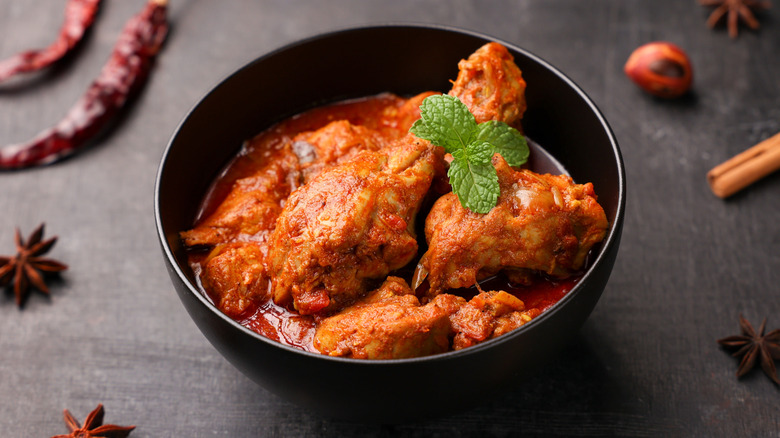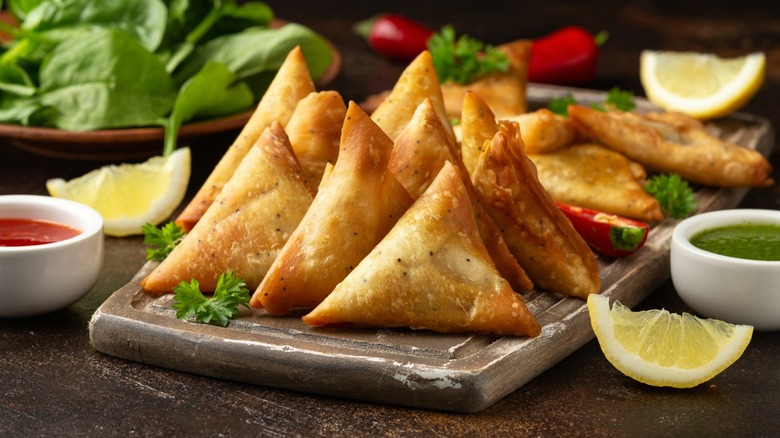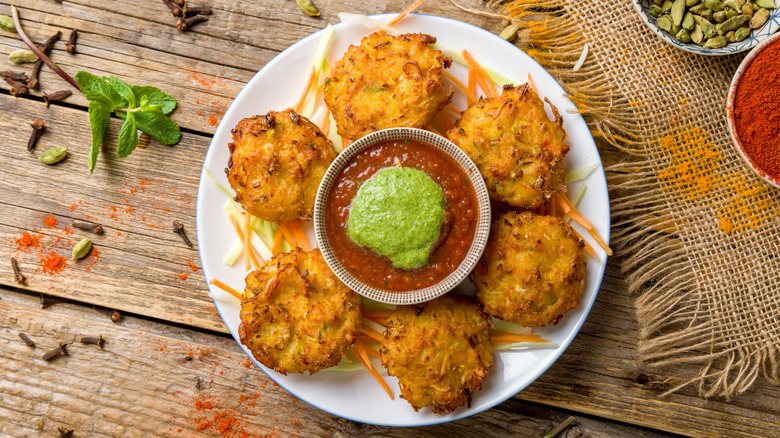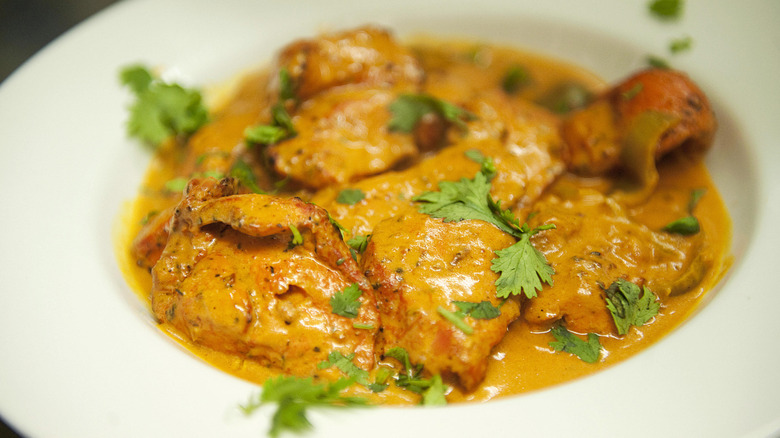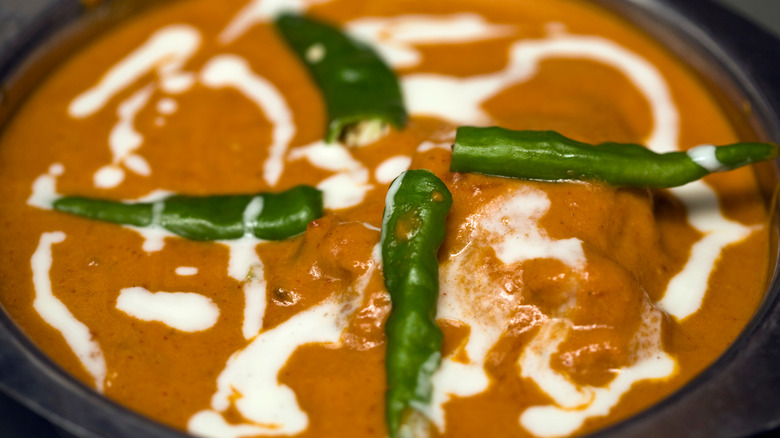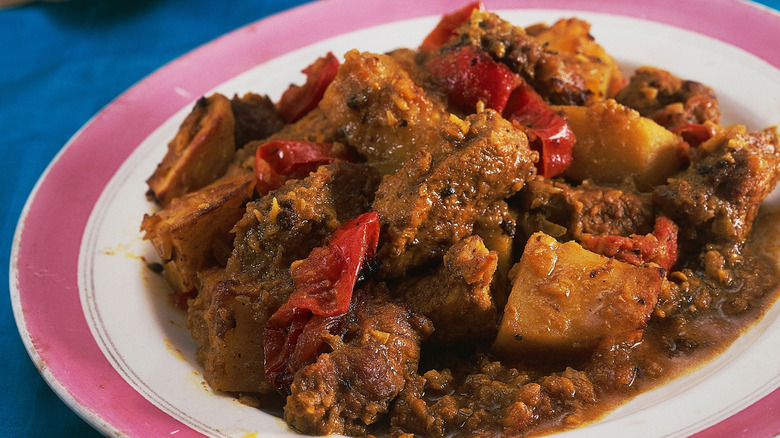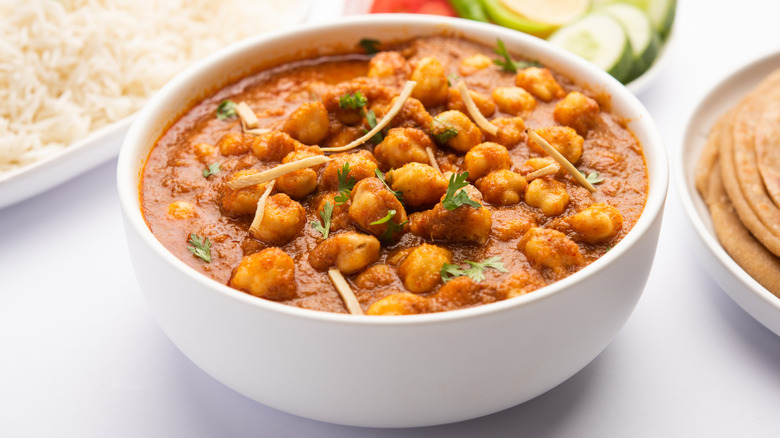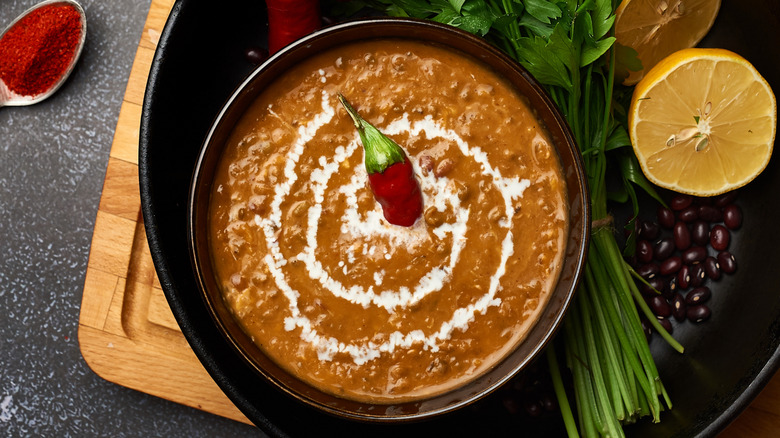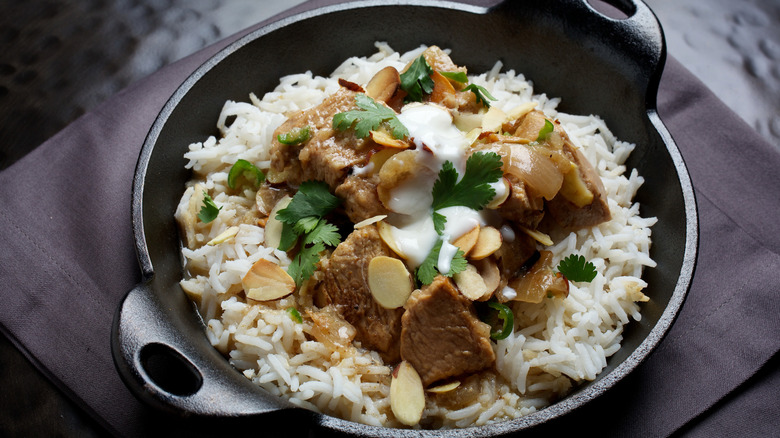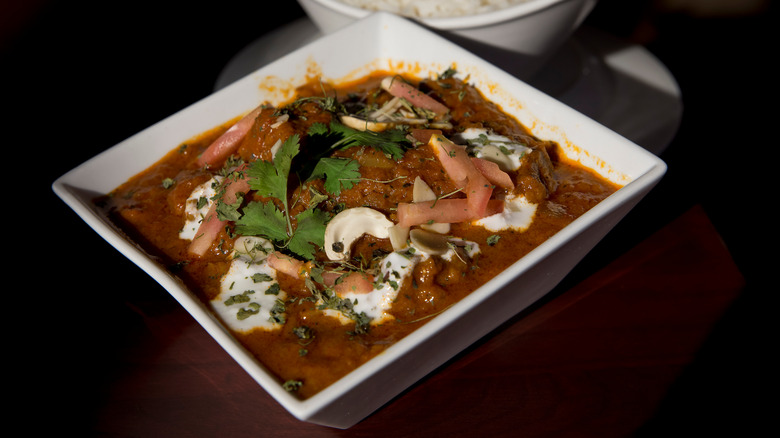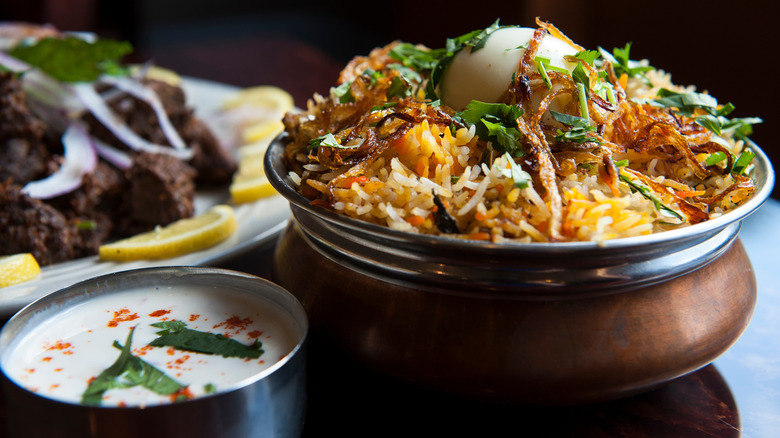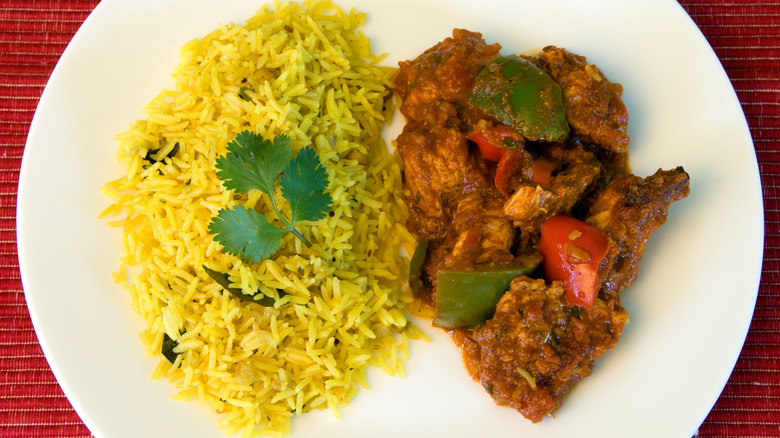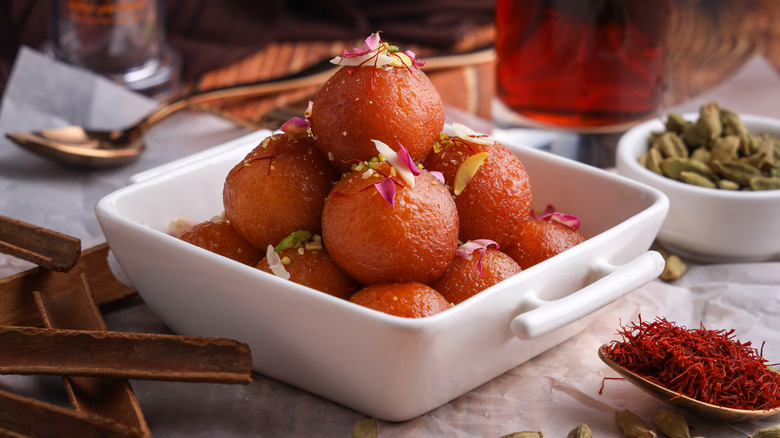A Cheat Sheet To Indian Restaurant Menus
Let's get the big, flashing misnomer out of the way: Not every stew at an Indian restaurant is a curry. It's understandable how it's become shorthand for "meat-filled spicy sauce to dip roti in," but that's a gross generalization for a cuisine that's breathtaking in its diversity.
Part of the problem is that some restaurant menus haven't done the best job articulating the distinctions of vindaloo from korma or tikka masala. "Lamb in savory sauce" and "chicken in aromatic gravy" isn't exactly the most evocative description.
What follows is a beginner's cheat sheet to the dishes you'll most likely encounter at your neighborhood Indian restaurant. True, there are ingredient commonalities: the spices used are typically a combination of turmeric, black pepper, chilies, cardamom, cloves, and the like. There's usually onion involved, sometimes tomato, and if there's a sauce, it's likely thickened with yogurt or cream (or both). But then it veers off into delicious tangents.
A brief preamble: It's worth noting while the scope of Indian cuisine is incredibly vast, the menus at Indian restaurants are dominated by what is called Mughlai cuisine, a category of north Indian food that's laden with rich, gravy-based meat and vegetable stews. This is less a function of Mughlai cuisine being the best or most popular food in India and more a function of the fact that many of the dishes within it use the same sauce (which, for a restaurant, makes them easy to produce in large quantities) and often involve meat (a seeming necessity for American palates). This is not to say the dishes aren't delicious, but it's a reminder that Indian food has a lot to offer beyond just what you'll find at these restaurants.
Samosas
Some dishes seem to be universal in their appeal, and the filled dumpling is certainly one of them — from Poland's pierogi to Japan's gyoza, people all over the world love a doughy snack with a surprise inside. The Indian version, samosas, is something you'll usually find on the appetizer section of an Indian restaurant menu since these triangular pastries tend to be small in size and great for sharing.
The classic samosa filling is made from peas and potatoes and is likely to be vegan as long as the dough isn't made with ghee. (Traditionally, it's not, but it never hurts to ask.) Sometimes chefs also like to get creative with other fillings, such as chickpeas, paneer cheese, chicken, or beef. Samosas can be deep-fried or baked and are typically accompanied by some sort of dipping sauce. Often, this is a tangy tamarind chutney or a cooling cilantro-mint one, but other dips, depending on the samosas' filling, might include a spicy garlic chutney or a creamy tomato sauce.
Pakoras
Pakoras, like samosas, are generally something you'll find as an appetizer at Indian restaurants. A pakora is a type of fritter dipped in a batter made from chickpea flour, which is also known as gram flour or besan. The fritters are then quickly deep-fried, making them light and crunchy.
Pakoras, like samosas, can come in either vegan or meaty versions. Some restaurants may feature a mixed vegetable pakora platter, while others might offer single pakoras such as cauliflower, aloo (potato), or even chile pepper. Meaty pakoras tend to be made with either chicken or fish, while some establishments also serve vegetarian-but-not-vegan options such as paneer or egg pakoras. The latter are made with hard-boiled eggs and resemble nothing so much as sausage-free Scotch eggs.
Pakoras, like samosas, are also usually accompanied by dipping sauces. For the most part, these dips tend to overlap, although Indian restaurants in the U.K. serve a pink pakora sauce that combines mint sauce with mango chutney and adds yogurt, ketchup, onions, chiles, and cumin for a uniquely Anglo-Indian flavor experience.
Chicken tikka masala
More British than Indian (it's regarded by some as the national dish of England), chicken tikka masala begins with tandoori chicken, where the skinless bird has been marinated in a spiced yogurt sauce and then cooked in a tandoor (clay oven) until juicy and smoky. Tandoori chicken in and of itself is a wonderful dish, but chicken tikka masala takes it one step further by simmering it in a sauce made of onions, tomatoes, and cream (or yogurt).
The dish is known for its safety-cone-orange color, usually from turmeric and paprika in the sauce, but sometimes because of added orange food coloring. Some restaurants will give the tikka masala treatment to lamb or even beef, but chicken is the O.G. protein.
Butter chicken
Butter chicken is a classic Indian truck stop dish that's as straightforward as it sounds: Chicken gets cooked in a tomato and butter gravy (or literally just butter) until the meat is fall-off-the-bone soft. Butter chicken will often look very similar to chicken tikka masala; the difference is that tikka masala has more of a complex, layered flavor from the spices, while butter chicken tastes like, well, butter, with a milder, sweeter gravy.
Vindaloo
Vindaloo is a south Indian dish with many variations. The version you'll likely see in an Indian restaurant will include some kind of meat base cooked with red chiles, vinegar, garlic, and sometimes potatoes. In India, the dish is known for its unmitigated spiciness. But at your neighborhood Indian joint, chances are the heat has been tamed — unless you ask for it spicy.
Chana masala
The name tells you everything you need to know: Chana means chickpeas, and masala means spices. Chana masala, which happens to be a very popular street food in northern India, consists of boiled chickpeas that have been cooked in a tomato-onion gravy. A special feature of chana masala is that the spices in it are often over-toasted — this is what gives the most flavorful versions of the dish their dark hue and deep, roasted flavor.
Dal makhani
You may think that a lentil stew would be a healthy alternative to the otherwise rich offerings at a lot of Indian restaurants, but in the case of dal makhani, you would be wrong. The dish literally translates to "buttered lentils."
This is a classic vegetarian restaurant staple, made with black lentils that have been cooked with lots of butter, cream, and a clove- and black-pepper-heavy spice mixture — plus (sometimes) a little bit of jaggery, for sweetness. The taste, oddly enough, is reminiscent of drinking chai — creamy with a slight kick, but very subdued. In the cooking process, the lentils get soft, like a thick porridge.
Korma
Korma is meat (usually chicken or lamb) braised in a garlic- and ginger-spiked yogurt sauce. It's cooked using the low-and-slow method so that the yogurt doesn't curdle, yielding a tender, mild stew. If your korma tastes extra rich, that's probably because the gravy has ground cashews or almonds in it — an extra piece of flair often added to enrich the taste.
Rogan josh
With most Indian dishes, you can select your choice of meat. When it comes to rogan josh, lamb is the only option. The key to its smoky and sweet taste is the base, which consists of onions that have been browned in oil or ghee (clarified butter) until essentially caramelized, as well as the heavy dose of bracing, warming spices like whole cardamom and clove.
You might see on a menu that the dish has chiles, but don't worry — the chiles used in rogan josh are usually mild ones. If you're at a good Indian restaurant, your rogan josh might be finished with a touch of saffron.
Biryani
There's nothing not to love about biryani: soft, long-grain basmati rice, tender chunks of meat, layered, warm spices (cardamom is usually key), and loads of ghee, all cooked in a pot over slow fire. On the surface, biryani can look like just a pot of steamed rice, as there's no actual "sauce" involved. What makes it truly luxurious is the way that the ghee clings onto — and enriches — each grain of rice and morsel of meat, plus the all-consuming aroma of the whole spices (most of which are left in the biryani itself) when you initially lift the top off the dish.
There are countless takes on biryani: some vegetarian, some finished with raisins, some with gold foil on top for extra pizzazz. The point is you can't go wrong, no matter what kind you get.
Jalfrezi
The name of the game here is sizzling meat and vegetables (or just vegetables) that have been dry-fried on very high heat with plenty of chiles. Jalfrezi is pretty spicy, as there's no gravy to cut through the heat, though many restaurants will tone it down by adding cream or yogurt. This is a close analogue to stir-fry or fajitas, but with the piquancy levels turned way, way up.
Gulab jamun
If you want the entire Indian restaurant experience, you'll need to work your way all through the menu until you come to the dessert section, and it's there you're likely to find gulab jamun. It's one of the most popular sweets in India, although it may have originated in the Middle East. This dairy-heavy dessert is made from a dough that may include both dry and fresh milk, although some restaurants make their gulab jamun with cottage cheese, either instead of or in addition to these other ingredients. The dough is then shaped into small balls and deep-fried, at which point the balls look somewhat like mini donut holes.
What gives gulab jamun its signature flavor, however, is the fact that the dough balls, once cooked, are then soaked in sugar syrup like a booze-free baba au rhum. Depending on where you dine, the syrup for the gulab jamun may be flavored with either cardamon or rose water, the latter of which harks back to the dish's Persian roots. The word "gul" (or "gol"), in fact, is Farsi for "rose," while "ab" means "water." In some cases, however, both flavorings can be used, and the syrup may also contain a bit of lemon juice. Gulab jamun is sometimes garnished with coconut as well as almonds or pistachios (or both), with the latter two lending a bit of crunch to offset the squish.
